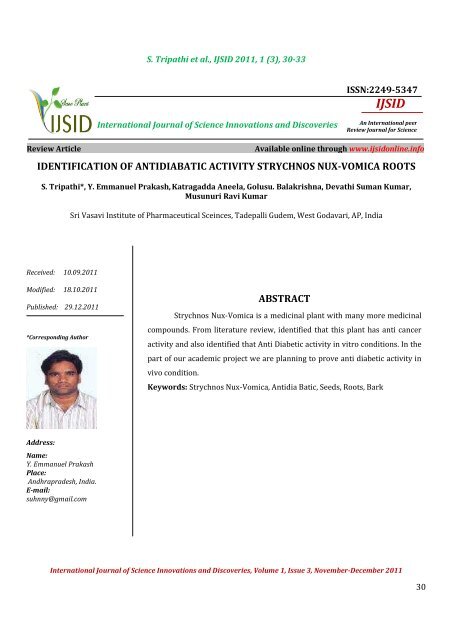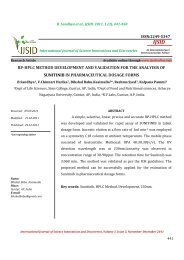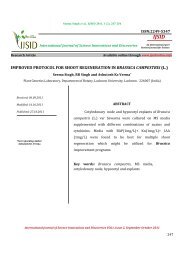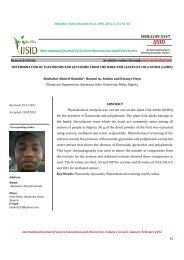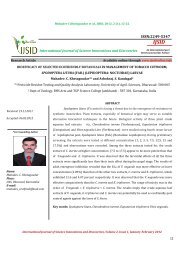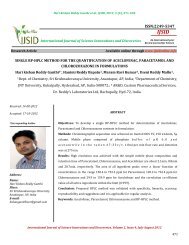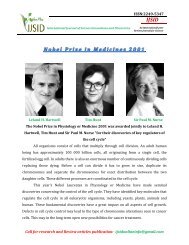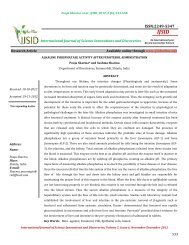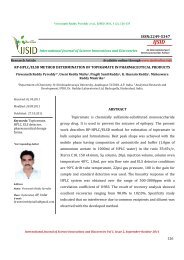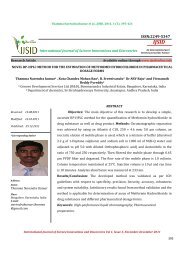identification of antidiabatic activity strychnos nux-vomica roots
identification of antidiabatic activity strychnos nux-vomica roots
identification of antidiabatic activity strychnos nux-vomica roots
Create successful ePaper yourself
Turn your PDF publications into a flip-book with our unique Google optimized e-Paper software.
S. Tripathi et al., IJSID 2011, 1 (3), 30-33<br />
IDENTIFICATION OF ANTIDIABATIC ACTIVITY STRYCHNOS NUX-VOMICA ROOTS<br />
S. Tripathi*, Y. Emmanuel Prakash, Katragadda Aneela, Golusu. Balakrishna, Devathi Suman Kumar,<br />
Musunuri Ravi Kumar<br />
Sri Vasavi Institute <strong>of</strong> Pharmaceutical Sceinces, Tadepalli Gudem, West Godavari, AP, India<br />
INTRODUCTION<br />
INTRODUCTION<br />
ISSN:2249-5347<br />
IJSID<br />
International Journal <strong>of</strong> Science Innovations and Discoveries An International peer<br />
Review Journal for Science<br />
Review Article Available online through www.ijsidonline.info<br />
Received: 10.09.2011<br />
Modified: 18.10.2011<br />
Published: 29.12.2011<br />
*Corresponding Author<br />
Address:<br />
Name:<br />
Y. Emmanuel Prakash<br />
Place:<br />
Andhrapradesh, India.<br />
E-mail:<br />
suhnny@gmail.com<br />
ABSTRACT<br />
Strychnos Nux-Vomica is a medicinal plant with many more medicinal<br />
compounds. From literature review, identified that this plant has anti cancer<br />
<strong>activity</strong> and also identified that Anti Diabetic <strong>activity</strong> in vitro conditions. In the<br />
part <strong>of</strong> our academic project we are planning to prove anti diabetic <strong>activity</strong> in<br />
vivo condition.<br />
Keywords: Strychnos Nux-Vomica, Antidia Batic, Seeds, Roots, Bark<br />
International Journal <strong>of</strong> Science Innovations and Discoveries, Volume 1, Issue 3, November-December 2011<br />
30
S. Tripathi et al., IJSID 2011, 1 (3), 30-33<br />
INTRODUCTION<br />
Strychnos <strong>nux</strong>-<strong>vomica</strong> is a medium-sized tree with a short, crooked, thick trunk, the wood is white hard,<br />
close grained, durable and the root very bitter. Branches irregular, covered with a smooth ash coloured bark;<br />
young shoots deep green, shiny; leaves opposite, short stalked, oval, shiny, smooth on both sides, about 4 inches<br />
long and 3 broad; flowers small, greeny-white, funnel shape, in small terminal cymes, blooming in the cold season<br />
and having a disagreeable smell. Fruit about the size <strong>of</strong> a large apple with a smooth hard rind or shell which when<br />
ripe is a lovely orange colour, filled with a s<strong>of</strong>t white jelly-like pulp containing five seeds covered with a s<strong>of</strong>t<br />
woolly-like substance, white and horny internally. The seeds are removed when ripe, cleansed, dried and sorted;<br />
they are exported from Cochin, Madras and other Indian ports. The seeds have the shape <strong>of</strong> flattened disks densely<br />
covered with closely appressed satiny hairs, radiating from the centre <strong>of</strong> the flattened sides and giving to the seeds<br />
a characteristic sheen; they are very hard, with a dark grey horny endosperm in which the small embryo is<br />
embedded; no odour but a very bitter taste. Nux Vomica contains the alkaloids, Strychnine and Brucine, also traces<br />
<strong>of</strong> strychnicine, and a glucoside Loganin, about 3 per cent fatty matter, caffeotannic acid and a trace <strong>of</strong> copper. The<br />
pulp <strong>of</strong> the fruit contains about 5 per cent <strong>of</strong> loganin together with the alkaloid strychnicine.<br />
Availability<br />
The Strychnine tree (Strychnos <strong>nux</strong>-<strong>vomica</strong> L.) also known as Nux <strong>vomica</strong>, Poison Nut, Semen <strong>strychnos</strong><br />
and Quaker Buttons, is a deciduous tree native to India, southeast Asia, a member <strong>of</strong> family Loganiaceae.<br />
Medicinal Application<br />
The properties<strong>of</strong> Nux Vomica are substantially those <strong>of</strong> the alkaloid Strychnine. The powdered seeds are<br />
employed in atonic dyspepsia. The tincture <strong>of</strong> Nux Vomica is <strong>of</strong>ten used in mixtures - for its stimulant action on the<br />
gastro-intestinal tract. In the mouth it acts as a bitter, increasing appetite; it stimulates peristalsis, in chronic<br />
constipation due to atony <strong>of</strong> the bowel it is <strong>of</strong>ten combined with cascara and other laxatives with good effects.<br />
Strychnine, the chief alkaloid constituent <strong>of</strong> the seeds, also acts as a bitter, increasing the flow <strong>of</strong> gastric juice; it is<br />
rapidly absorbed as it reaches the intestines, after which it exerts its characteristic effects upon the central nervous<br />
system, the movements <strong>of</strong> respiration are deepened and quickened and the heart slowed through excitation <strong>of</strong> the<br />
vagal centre. The senses <strong>of</strong> smell, touch, hearing and vision are rendered more acute, it improves the pulse and<br />
raises blood pressure and is <strong>of</strong> great value as a tonic to the circulatory system in cardiac failure. Strychnine is<br />
excreted very slowly and its action is cumulative in any but small doses; it is much used as a gastric tonic in<br />
dyspepsia. The most direct symptom caused by strychnine is violent convulsions due to a simultaneous stimulation<br />
<strong>of</strong> the motor or sensory ganglia <strong>of</strong> the spinal cord; during the convulsion there is great rise in blood pressure; in<br />
some types <strong>of</strong> chronic lead poisoning it is <strong>of</strong> great value. In cases <strong>of</strong> surgical shock and cardiac failure large doses<br />
are given up to 1/10 grain by hypodermic injection; also used as an antidote in poisoning by chloral or chlor<strong>of</strong>orm.<br />
Brucine closely resembles strychnine in its action, but is slightly less poisonous; it paralyses the peripheral motor<br />
International Journal <strong>of</strong> Science Innovations and Discoveries, Volume 1, Issue 3, November-December 2011<br />
31
S. Tripathi et al., IJSID 2011, 1 (3), 30-33<br />
nerves. It is said that the convulsive action characteristic <strong>of</strong> strychnine is absent in brucine almost entirely. It is<br />
used in pruritis and as a local anodyne in inflammations <strong>of</strong> the external ear.<br />
Poisoning and Antidotes<br />
In cases <strong>of</strong> poisoning by strychnine an emetic or the stomach pump should be used at once and tannin or<br />
potassium permanganate given to render the strychnine inactive. Violent convulsions should be controlled by<br />
administration <strong>of</strong> chlor<strong>of</strong>orm or large doses <strong>of</strong> chloral or bromide. Urethane in large doses is considered an<br />
antidote. Amyl nitrite is also useful owing to its rapid action during the convulsion, and in absence <strong>of</strong> respiration 3<br />
to 5 minims may be hypodermically injected.<br />
The effects on the sensorium are as follows: There is indisposition to mental exertion, and particularly to<br />
that form which involves the elaboration and connections <strong>of</strong> subjective ideas independently <strong>of</strong> external objects<br />
(subjective ratiocination). The prover easily errs in speaking or writing. This corresponds with a certain manual<br />
clumsiness. Vertigo is produced, with momentary loss <strong>of</strong> consciousness, obscuration <strong>of</strong> vision and staggering. It<br />
occurs more particularly while eating and immediately after eating; when walking and even when lying down in<br />
bed. It resembles vertigo produced by alcohol; for which, indeed, Nux is a specific remedy.<br />
Effect <strong>of</strong> Nux Vomica on Body Organs<br />
Head: Nux produces, moreover, confusion and dullness in the head, especially in the morning and after meals and<br />
also great and bewildering heaviness, especially on stooping. The headache is pressing, tensive and drawing. It<br />
affects chiefly the forehead and the supra-orbital region. Sometimes extending through the base <strong>of</strong> the brain to the<br />
occiput, it is sometimes described as a feeling <strong>of</strong> internal soreness, as though one had received a blow with an ax.<br />
With the acute headache are conjoined almost always qualmishness, nausea and even vomiting. When the prover<br />
walks, the brain feels shattered. Externally the scalp is sensitive and sore. Rhus toxicodendron has the sensation<br />
when the patient walks, and especially when he goes upstairs, as if at every step or rising the brain were loose and<br />
struck against the skull; hence worse from motion. China has, along with a sensation <strong>of</strong> great fullness in the head<br />
and outward pressure in the temples, a feeling as if the brain were balancing to and fro within the cranium and<br />
were striking against the skull, occasioning great pain and obliging one to move the head (hence better from<br />
motion).<br />
Face: The chief symptoms noted on the face are small papules,—some <strong>of</strong> which even contain pus, isolated,<br />
occurring on the forehead, cheeks and scalp, a kind <strong>of</strong> acne. Nux is a remedy for the acne which is aggravated by<br />
eating cheese, although the great constipation sometimes produced by cheese is relieved by Colocynth.<br />
Eyes: Drawing and pressing pains in the eye-lids, the margins <strong>of</strong> which become thickened and sore, the lids are<br />
agglutinated in the morning, in the eyes themselves biting, burning and itching, relieved by rubbing. The<br />
conjunctiva sometimes becomes very red, and there is great photophobia.Clinical experience has led me to regard<br />
morning and forenoon photophobia as especially indicating Nux <strong>vomica</strong>. The patient covers the eyes or buries the<br />
head in a pillow in the forenoon, and looks around without suffering in the afternoon. . As regards the special sense,<br />
International Journal <strong>of</strong> Science Innovations and Discoveries, Volume 1, Issue 3, November-December 2011<br />
32
S. Tripathi et al., IJSID 2011, 1 (3), 30-33<br />
there have been observed a glittering appearance just outside the field <strong>of</strong> distinct vision, and also black and gray<br />
points floating before the eyes.<br />
Other Species in this Family<br />
Strychnos tieute, a clumbing shrub growing in Java, gives a juice termed Upas tieute, said to be used by the<br />
natives as an arrow poison; it produces death by violent convulsions, the heart stopping before respiration. S.<br />
toxifera yields the deadly poison Curare (Woorari or Urari) used by the natives <strong>of</strong> British Guiana. S. ligustrina, the<br />
wood <strong>of</strong> which contains brucine, as does the bark.<br />
S. pseudo is found in the mountains and forests <strong>of</strong> India. It supplies the seeds known as clearing nuts. The<br />
fruit is black, the size <strong>of</strong> a cherry, containing only one seed; fruit and seeds are used medicinally in India and also to<br />
clear muddy water, the seeds being rubbed for a minute inside the vessel and the water then allowed to settle;<br />
their efficiency depending on their albumen and casein contents acting as a fining agent similar to those employed<br />
to clarify wine and beer. S innocua, the fruit and pulp are harmless and are eaten by the natives <strong>of</strong> Egypt and<br />
Senegal. S Ignatii is found in the Philippines, the seeds containing strychnine and brucine, strychnine being present<br />
in greater quantity than in Nux Vomica. A tincture made from the beans is <strong>of</strong>ficial in the British Pharmacopoeia<br />
Codex.<br />
CONCLUSION<br />
Based on the complete study and results, it proves that STRYCHNOS NUX-VOMICA plant root have Anti diabetic<br />
<strong>activity</strong> and other studies were under progress.<br />
REFERENCES<br />
1. Arnold, M.D., Harry L. (1968). Poisonous Plants <strong>of</strong> Hawaii. Tokyo, Japan: Charles E. Tuttle Co. p. 20.<br />
2. David Michael Wood et al. Case report: Survival after deliberate strychnine self-poisoning, with toxicokinetic data. Critical<br />
Care October 2002 Vol 6 No 5<br />
3. Duddukuri GR, Brahmam AN, Rao DN"Suppressive effect <strong>of</strong> <strong>strychnos</strong> <strong>nux</strong>-<strong>vomica</strong> on induction <strong>of</strong> ovalbumin-specific IgE<br />
antibody response in mice." Indian J Biochem Biophys. 2008 Oct;45(5):341-4<br />
4. Lee SM, Kwon JI, Choi YH, Eom HS, Chi GY.,"Induction <strong>of</strong> G2/M arrest and apoptosis by water extract <strong>of</strong> Strychni Semen in<br />
human gastric carcinoma AGS cells." Phytother Res. 2008 Jun;22(6):752-8<br />
5. Akbar S, Khan SA, Masood A, Iqbal M"Use <strong>of</strong> Strychnos <strong>nux</strong>-<strong>vomica</strong> (Azraqi) seeds in Unani system <strong>of</strong> medicine: role <strong>of</strong><br />
detoxification." Afr J Tradit Complement Altern Med. 2010;7(4):286-90<br />
6. Han QB, Li SL, Qiao CF, Song JZ, Cai ZW, Pui-Hay But P, Shaw PC, Xu HX.,"A Simple Method to Identify the Unprocessed<br />
Strychnos Seeds used in Herbal Medicinal Products." Planta Med. 2008 Mar;74(4):458-63<br />
7. H<strong>of</strong>bauer R, Pasching E, Moser D, Frass "Heparin-binding epidermal growth factor expression in KATO-III cells after<br />
Helicobacter pylori stimulation under the influence <strong>of</strong> <strong>strychnos</strong> Nux <strong>vomica</strong> and Calendula <strong>of</strong>ficinalis"., Homeopathy.<br />
2010 Jul;99(3):177-82M<br />
8. Grieve, M.. "Nux Vomica". Botanical.com, a Modern Herbal. 3 Nov 2010.<br />
9. "Strychnos Nux-<strong>vomica</strong>". American Cancer Society. Retrieved 3 Nov 2010.<br />
International Journal <strong>of</strong> Science Innovations and Discoveries, Volume 1, Issue 3, November-December 2011<br />
33


